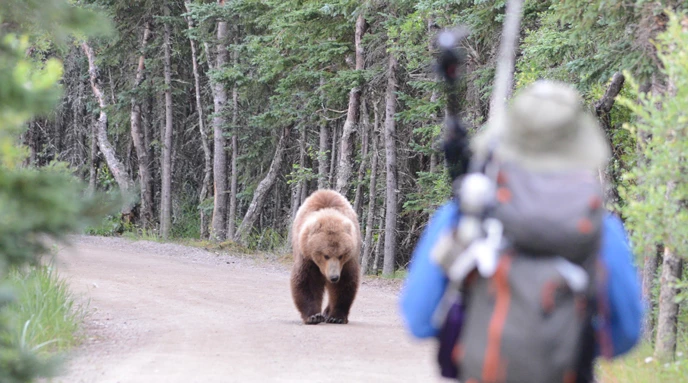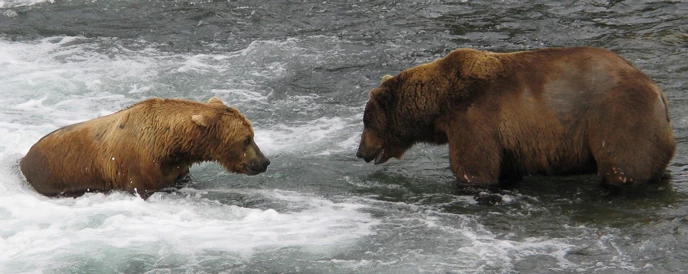
Jake Bortscheller photo
In general, Katmai’s brown bears react to people and other bears at lesser distances than an inland grizzly bear. However, each bear is an individual and has individual tolerances toward people. Giving bears space is one of the most important guidelines to follow. Treat each bear as an individual, each bear encounter as unique, and follow the suggestions below during your visit. Avoid Close Encounters Hike and Travel in Groups Groups of four or more people are typically very safe in bear country. Groups of people are usually noisier and smellier than a single person. Therefore, bears often become aware of groups of people at greater distances, and because of their cumulative size groups of people are also passively intimidating to bears. Hiking and traveling in groups is typically the best way to increase your level of safety in bear country. Be Alert Katmai’s bears are mostly diurnal (active during the day) but are also active at night and can be found in all of Katmai’s habitats. Never assume you are in a “bear free” area. Be on the lookout for signs of bears and be especially wary in areas where bears may have trouble detecting you. Sometimes, you might see a bear before it is aware of you. In these situations, back away quietly the same way you came and give the bear space. Make Noise In areas where visibility is limited make noise to warn bears of your approach. Brown bears can react defensively if they are surprised. The human voice is the best tool to warn bears of your approach. Bears may not associate other noise makers, such as bells, with people. Please remember that you are not making noise to scare bears away, only to warn them of your approach. Once a bear is aware of your presence it is usually not necessary to make extra noise. Do Not Approach Bears You should always avoid interfering with bear movement or foraging activities. If a bear reacts to your presence you are too close. Bears are creatures of habit and habitually use the same travel routes. Many close encounters can be avoided if you move out of a bear’s line of travel before it is close. Additionally, people are prohibited from approaching bears within 50 yards or remaining within 50 yards of a bear using a concentrated food source including, but not limited to, animal carcasses, spawning salmon, and other feeding areas. Steer Clear of Places with Food that Attract Bears Salmon streams, mud flats with clams, and sedge meadows are areas that attract bears and consequently people who want to watch them. Anglers are also attracted to streams where salmon are actively spawning. Since most people visit Katmai to either see bears or fish in streams where bear encounters are likely, it can be difficult to stay clear of areas with food that attract bears. However, please consider fishing when bears are not at peak numbers (like on the Brooks River in June and August) and/or viewing bears at a distance, not, for example, from the middle of a sedge meadow or a salmon stream.
During a Bear Encounter Your response during a bear encounter should depend on the bear’s behavior. Curious bears have different motivations than defensive bears. You can find more information on the motivations of a curious bear versus a defensive bear on bearsmart.com and in thebear safety information for Yellowstone National Park. The information below has been gleaned from many sources including books, resource experts, and videos. Assess the Bear’s Behavior Bear encounters often happen very quickly, but the bear will likely be showing cues that communicate its intentions. When you encounter a bear always stop, remain calm, and assess the situation.

NPS 
NPS A bear may approach closely or stand on its hind legs to identify you. Identify yourself as a human by talking to the bear calmly and waving your arms slowly above your head. Back away slowly if you can. If you are traveling in a group, use the group’s size to your advantage and stay close to one another. Don't Run! Running may encourage a bear to chase you. Bears can run faster than 30 miles per hour (50 km/hr). You cannot outrun them. If You are Charged A defensive bear may approach you or even charge. If a bear charges, it perceives you as threat. Most charges are bluffs, but you must take action to try to appear non-threatening by standing your ground and talking calmly to the bear. Don’t shout or throw anything. Once the bear has stopped its charge, try to move slowly away. If the bear charges again as you are moving away, stop moving and stand your ground again. Use your bear spray if you think the bear will attack. Even though most charges are bluffs, there is no cue from the bear indicating that the charge is a bluff. If a Defensive Bear Attacks Play dead. Fall to the ground face down on your stomach with your legs apart. Lock your hands behind your neck to protect your neck and face. If you do get rolled over, keep rolling until you're face down again. Don’t shout or cry out. Stay quietly in this position until the bear has left the area. Once a defensive bear no longer perceives you as a threat, it will stop attacking. If the attack continues long after you have assumed the protective position, fight back vigorously. If a Non-Defensive Bear Approaches A non-defensive bear may approach you for are a variety of reasons — it may be conditioned to human food, curious, or want to test its dominance. Non-defensive bears usually don’t show any signs of stress, so you should act assertively. You are trying to dissuade the bear from approaching. As with a defensive bear, stay calm and speak to the bear. Try moving out of its way. If the bear continues to approach, you then want to assert your dominance over the animal — shout, make yourself look large and threatening, throw a rock towards the bear, and prepare to use your bear spray. If a Non-Defensive Bear Attacks In North America, brown bear attacks are very rare and non-defensive attacks by brown bears are even more rare. Brown bear attacks are almost always defensive, but if it is not then fight back. Non-defensive bears may consider you prey. In All Cases The best defense is knowledge, preparation, and prevention. Arm yourself with a knowledge of bear biology, ecology, and behavior. Prepare yourself mentally for bear encounters before you visit Katmai, and take action when you are visiting Katmai to prevent bear encounters. When you visit Katmai, you have a responsibility to protect the experience, everyone’s safety, and Katmai’s bears. |
An official website of the United States government
Here's how you know
Official websites use .gov
A
.gov website belongs to an official government
organization in the United States.
Secure .gov websites use HTTPS
A
lock (
) or https:// means you've safely connected to
the .gov website. Share sensitive information only on official,
secure websites.
